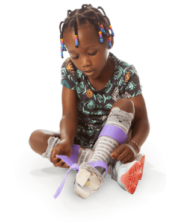Erb's palsy statistics in the United States

Erb's palsy, also called brachial plexus birth palsy or Erb-Duchenne paralysis, can happen to a person at any age but is far more common at birth.
In fact, Erb’s palsy is one of the more common birth injuries, affecting about 12,000 live births in the United States each year.
When a child has Erb’s palsy, one of their arms will likely hang, with their wrist turning inwards in what is often referred to as a "waiter's tip" position.
It is estimated that as many as 2 in every 1,000 babies born in the U.S. are born with Erb’s palsy.
Download our FREE guide to get additional information on Erb’s palsy statistics and more.
Erb's palsy statistics on causes
Injuries to the brachial plexus nerves can happen for various reasons, many of them related to either the mother's health or the infant's health and size. Difficult deliveries are one of the most common causes of Erb’s palsy.
The condition can also be caused by a medical mistake during childbirth. Here are Erb’s palsy statistics on medical negligence.
Birth injury and medical negligence
In some instances, Erb's palsy is due to the negligence of a doctor, midwife, nurse, or other health care provider. When this happens, it means the condition could have been prevented with proper care.
When a medical mistake is the cause, some families choose to file an Erb’s palsy lawsuit to seek the financial compensation they need to properly care for their child.
- Complications from delivery tools such as forceps or vacuum extractors
- Failure to perform a necessary cesarean section (C-section)
- Using excessive force or pulling when guiding a baby out of the birth canal
If you suspect your child’s condition was caused by medical negligence, we may be able to help. Get a free case review now to find out how.
Erb's palsy statistics and medical malpractice
Roughly 20,000 medical malpractice lawsuits are filed in the U.S. every year, many of which involve brachial plexus injuries at birth.
Is Erb's palsy permanent?
Erb's palsy is not always permanent. Mild cases can resolve within months, while severe cases may require therapy or surgery.
Settlements for Erb's palsy lawsuits vary widely depending on the severity of the condition, but birth injury payouts generally average $1,000,000 for children under one month old.
Erb’s palsy cases that involve lifelong disability may result in payouts of several million dollars.
The best way to find out if your family could be eligible to receive money through a birth injury lawsuit is to connect with an experienced Erb’s palsy lawyer.
Erb's palsy statistics on risk factors
Depending on the situation and circumstances, any child could be at risk for developing Erb's palsy during the birthing process.
However, according to Erb's palsy statistics, some children have an increased chance of being affected by the condition.
Breech delivery
A breech birth is when a baby is in the feet-first position at the start of labor. It occurs in about 3% to 4% of deliveries. A C-section is often recommended to ensure a safe delivery when a baby is in a breech position.
There are rare instances where a baby can be delivered vaginally in a breech position, but this can put the baby at an increased risk for nerve damage associated with Erb's palsy, as it puts additional pressure and strain on the infant's raised arms.
High birth weight
A baby with a higher-than-average birth weight, or macrosomia, can lead to a difficult delivery and is one of the potential causes of Erb’s palsy.
According to Erb's palsy statistics, about 8% of babies are larger than average, weighing over 8 pounds and 13 ounces.
Improper use of delivery tools
 The Centers for Disease Control and Prevention (CDC) reported in 2018 that only about 3% of vaginal births required the use of delivery tools, and their use is becoming less common over time.
The Centers for Disease Control and Prevention (CDC) reported in 2018 that only about 3% of vaginal births required the use of delivery tools, and their use is becoming less common over time.
While assistive delivery tools are generally safe, vacuum extraction injury and forceps delivery complications do occur. Among the deliveries where assistive tools were used, 80% of the procedures involved vacuum extraction.
According to Erb's palsy statistics, complications from delivery tools are known to cause the condition.
Maternal diabetes
As of 2021, 8.3% of pregnant women receive a diagnosis of gestational diabetes each year.
This condition occurs when a pregnant woman's body does not produce enough insulin, and it can be life-threatening if left untreated for both the mother and baby.
Maternal obesity
According to the CDC, around 1 in 4 women are obese when they become pregnant.
Obesity during pregnancy is a growing concern in the United States, as it can lead to many complications, including a heightened risk of certain birth injuries, like Erb's palsy.
Shoulder dystocia
Shoulder dystocia occurs when an infant’s shoulder becomes lodged behind the mother’s pelvic bone, and the head delivers while the rest of the infant remains stuck in the birth canal.
Fortunately, this rare condition only occurs in about 1% of vaginal deliveries. However, this rate increases to 5% to 9% in babies of higher-than-average weight.
For many families, learning about Erb’s palsy statistics creates even more questions than they already had about their child’s birth injury. That’s why we have trained labor and delivery nurses on staff.
Speak with a registered nurse now in confidence — there is no cost or obligation.
Erb's palsy statistics on the 4 types
There are four types of Erb's palsy injuries, based on how the nerve was damaged and whether it was stretched or torn.
The type of brachial plexus birth injury significantly affects how treatable or curable the child's condition is and the extent of symptoms and pain they experience.
-
1. Neuropraxia
This type of Erb's palsy occurs when a nerve is damaged by stretching. It is the most manageable type to recover from.
Babies born with this type of brachial plexus injury may initially have a limited range of motion but often make a complete recovery within a few months, sometimes without any treatment.
-
2. Neuroma
Neuroma occurs from stretching of the nerve, but this type of nerve injury is more severe as it affects deeper tissues.
It is not usually possible to recover fully from this type of Erb’s palsy injury, as nerve fibers are often permanently damaged and left with scar tissue.
-
3. Rupture
This type of Erb's palsy involves tearing the nerve instead of stretching it, creating more permanent challenges for an infant or child.
It is estimated that roughly 20 million Americans are currently living with this type of nerve damage.
-
4. Avulsion
This type of Erb's palsy is the most serious and involves the nerve root being torn entirely from the spinal cord. Children with this form of Erb's palsy often have no mobility or motion in the affected arm.
Avulsion can also lead to a potentially severe condition called Horner's syndrome. This neurological condition affects a person's eyes and vision.
Erb’s palsy statistics on treatment options
In general, brachial plexus injuries are usually highly treatable. Many people recover fully when treatment is prompt and comprehensive.
In fact, 80% to 90% of infants with Erb’s palsy will make a full recovery within three to six months.
- Botox® injections
- Hydrotherapy
- Occupational therapy
- Physical therapy
- Surgery
When a case of Erb's palsy does not resolve on its own or through therapy, surgery is often required. Two types of surgeries used to treat Erb’s palsy are nerve grafts and nerve transfers.
Around 10% to 30% of Erb’s palsy cases are severe enough to require surgery.
Get help for an Erb’s palsy diagnosis
The team at Cerebral Palsy Guide has compiled these Erb's palsy statistics as part of our mission to help families affected by birth injuries.
Sadly, medical negligence can cause brachial plexus palsy injuries. When this happens, you shouldn't have to pay for your child's Erb's palsy treatment on your own. Financial aid may be available.
If your baby developed Erb’s palsy during childbirth, we may be able to help.
Connect with us now for a free case evaluation to find out if your family is eligible to receive compensation for medical bills and other costs.


